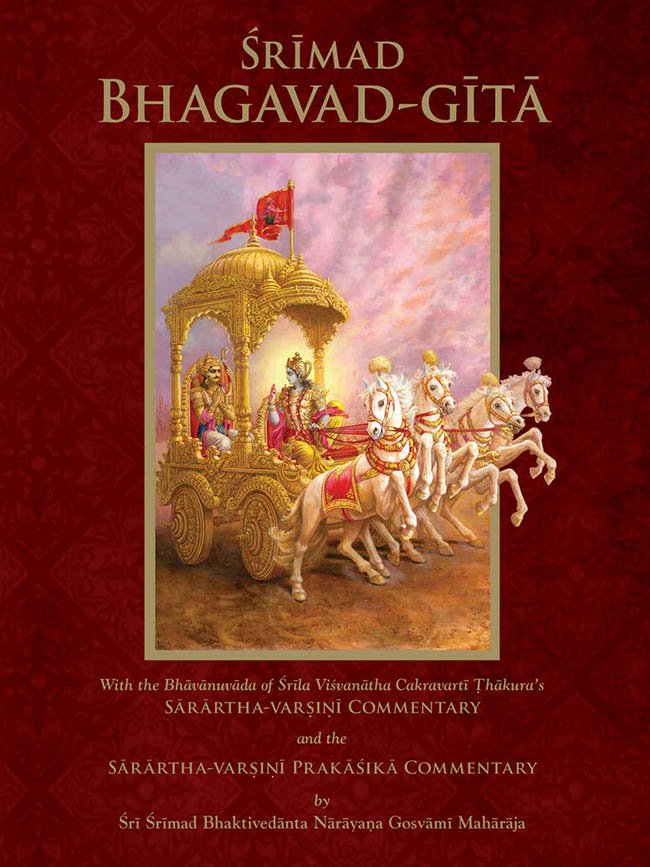Shrimad Bhagavad-gita
by Narayana Gosvami | 2013 | 327,105 words
The Bhagavad-gita Verse 8.3, English translation, including the Vaishnava commentaries Sarartha-varsini-tika, Prakashika-vritti and Rasika-ranjana (excerpts). This is verse 3 from the chapter 8 called “Taraka-brahma-yoga (the Yoga of Absolute Deliverance)”
Verse 8.3
Sanskrit text, Unicode transliteration, Word-for-word and English translation of verse 8.3:
श्री भगवान् उवाच–
अक्षरं परमं ब्रह्म स्वभावोऽध्यात्मम् उच्यते ।
भूत-भावोद्भव-करो विसर्गः कर्म-संज्ञितः ॥ ३ ॥śrī bhagavān uvāca–
akṣaraṃ paramaṃ brahma svabhāvo'dhyātmam ucyate |
bhūta-bhāvodbhava-karo visargaḥ karma-saṃjñitaḥ || 3 ||śrī bhagavān uvāca–the illustrious, all-opulent Lord said; akṣaram–the immutable; paramam–Supreme Truth; brahma–spirit; sva-bhāvaḥ–the nature of the living entity; adhyātmam–the constitutional nature of the self; ucyate–is known as; bhūta–for the living beings; bhāva–the creation of the material bodies, etc; udbhava-karaḥ–that which brings about; visargaḥ–the material existence of the individual soul; karma-saṃjñitaḥ–is known as karma.
Śrī Bhagavān said: Indeed the eternal, indestructible Supreme Truth is known as brahma. The living entity in his pure constitutional state is known as adhyātma, and the process of transmigrating through successive species of life, whereby the living entity undergoes birth, growth and so forth, is known as karma.
Commentary: Sārārtha-Varṣiṇī Ṭīkā
(By Śrīla Viśvanātha Cakravartī Ṭhākura; the innermost intention of the commentary named ‘the shower of essential meanings’)
While answering Arjuna’s questions, Śrī Bhagavān says that brahma is that which is imperishable and eternally supreme. “O Gārgī, the learned brāhmaṇas call it immutable (akṣara)” (Bṛhad-āraṇyaka Upaniṣad 3.8.9).
Svabhāvaḥ: Those who create material bodies because they identify their self (ātmā) with their body are called svabhāvaḥ, or living entities in the conditioned state. The word svabhāvaḥ also means ‘living entities in their constitutional position’, and it refers to those who situate themselves in their pure state by cultivating bhakti, thus attaining svaṃ (Paramātmā). Here svabhāvaḥ does not refer to the conditioned living entity but to the pure living entity, who is also known as adhyātma. The living entity’s cycle of birth and death in material existence, or visarga, results in the gross and subtle elements creating human and other bodies, according to the consciousness of the jīva: bhūta-bhāva-udbhava-karaḥ. The cycle of material existence is created by the action (karma) of the living entity, so here the word karma indicates the living entity’s material existence.
Commentary: Sārārtha-Varṣiṇī Prakāśikā-vṛtti
(By Śrīla Bhaktivedānta Nārāyaṇa Gosvāmī Mahārāja; the explanation that illuminates the commentary named Sārārtha-varṣiṇī)
Brahma means ‘that which does not perish’. It is called akṣara (immutable) because it is infallible. Akṣara-tattva is eternally free from destruction and transformation and is also called Parabrahma. Here it should be understood that only Bhagavān Śrī Kṛṣṇa, the Conscious Reality who possesses all transcendental attributes, is Parabrahma. Parabrahma does not refer to nirviśeṣa-brahma, His featureless impersonal aspect. Although the word akṣara refers to all three features of the Supreme, namely brahma, Paramātmā and Bhagavān, here it only indicates Parabrahma, or Svayam Bhagavān (Śrī Kṛṣṇa). One should deliberate on Gītā 15.16–18 for a detailed understanding of this subject.
This is also established in the prayers of Lord Brahmā (Śrīmad-Bhāgavatam 10.14.32):
yan-mitraṃ paramānandaṃ pūrṇaṃ brahma sanātanam
Śrī Kṛṣṇa, who is the complete, eternal brahma and whose form is composed of supreme bliss, is their friend.
This is also cited in Śrī Caitanya-caritāmṛta (Madhya-līlā 19.96):
aham iha nandaṃ vande yasyālinde paraṃ brahma
I forever worship Nanda Mahārāja in whose courtyard Parabrahma is playing as his son.
Adhyātma means svabhāvaḥ, or ‘the pure jīva situated in his unal-loyed state, free from any contact with inert matter’. Svaṃ bhāvayati means that one maintains the conception that ‘I am this gross body’ due to contact and identification with the body. There is another meaning of svabhāvaḥ, or svaṃ bhāvayati, which refers to the living entity who cultivates devotion to the Supreme Lord. Śrīpāda Baladeva Vidyābhūṣaṇa also translates the word svabhāvaḥ as jīvātmā (living entity): “jīvātmānaḥ sambandhī yo bhāvo–bhāva, or existence, in relationship with the living entity is called svabhāvaḥ.” That same jīvātmā who has taken shelter of the body considers himself to be the enjoyer of sense objects. Therefore, the word adhyātma refers to the living entity.
Visarga means ‘sacrifice performed by offering material ingredients for the pleasure of the demigods’. This gives rise to the gross and subtle elements, which in turn create the material world in the form of the living entities’ gross bodies. This should be understood as visarga, the material existence of the living entity.
